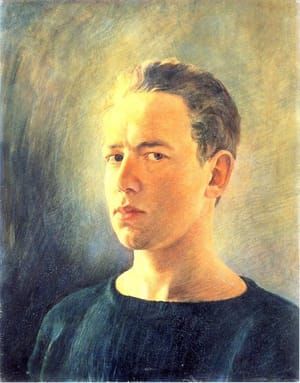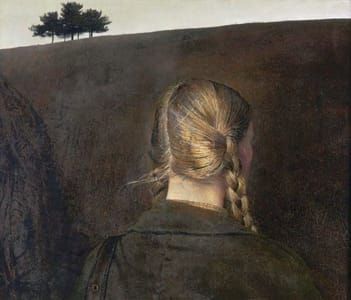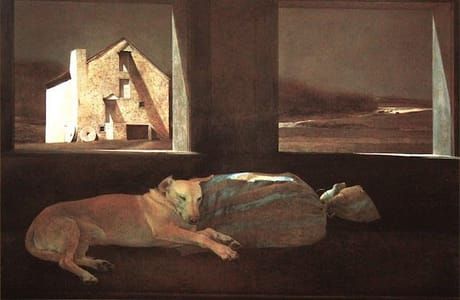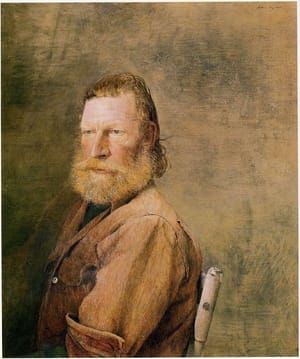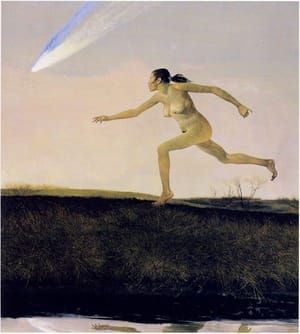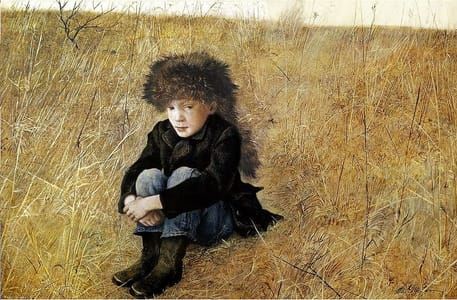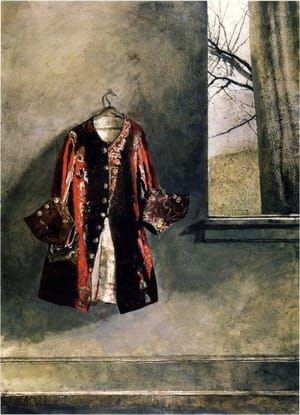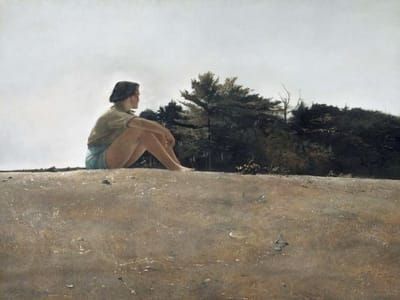
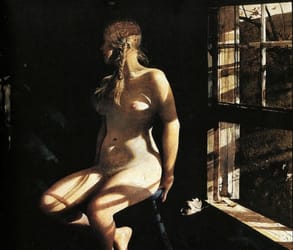
Lovers, 1981
Andrew Wyeth
Lovers, 1981, serves as an interesting contrast to Christina’s World. In the latter Wyeth depicted a paraplegic woman, clothed and alone in a wide world looking back at her own home. There is a sense of independence, and self-sufficiency.
In Lovers, Testorf is naked, sitting alone on a stool in a dark room, her head turned away, the window next to her, half-open, and her body lit only by mid-afternoon light. The shadows cast thick dark lines across her almost as though they are the bars on a cage. The hint of a similar hillside is offered, but Testorf is kept separated, unlike Christina, she is only treated to the illusion of an exterior world, not its reality. Her turned head is distinct from that of Christina’s: Testorf seems passive, almost ashamed, whereas Christina seems oblivious and uncaring of her viewer. The confident thrust of Christina’s body, held back only by her legs, contrasts the strange mix of the bent fingers of Testorf’s hand, trapped beneath her buttocks, and the stringy flaxen strands of her hair, which refuse to stay braided.
The scandal, which surrounded the pieces is unsurprising. Not because The Helga Pictures are somehow in the words of Jack Flam an “essentially tasteless endeavor”, but because they portray something almost too intimate. Christina’s World is aware of its viewer and its context, Wyeth was happy to share this scene with his audience, but Lovers is entirely something else, it is some private, and intimate, its execution was undertaken without any thought for anyone beyond its artist and its model.
Neither Wyeth’s son, Andrew, nor his wife have ever spoken extensively about the works, and Wyeth himself commented only that they were about ‘love’, which sheds little light on the true intentions or nature of the series. Unsurprisingly there are a rumours that the two had an affair, although this has never been confirmed. Ultimately, little of the conjecture matters, what remains is a striking body of work, which examines obsession, intimacy, time and sexuality.
(https://blog.lofty.com/featured/mondays-muse-helga-testorf/)
The Helga Pictures are a series of more than 240 paintings and drawings of German model Helga Testorf (born c. 1933 or c. 1939) created by Andrew Wyeth between 1971 and 1985.
....Wyeth asked Testorf to model for him in 1971, and from then until 1985 he made 45 paintings and 200 drawings of her, many of which depicted her nude. The sessions were a secret even to their spouses. The paintings were stored at the home of his student, neighbor and good friend, Frolic Weymouth.
...Explaining the series, Wyeth said, "The difference between me and a lot of painters is that I have to have a personal contact with my models. ... I have to become enamored. Smitten. That's what happened when I saw Helga." He described his attraction to "all her German qualities, her strong, determined stride, that Loden coat, the braided blond hair". Art historian John Wilmerding wrote, "Such close attention by a painter to one model over so long a period of time is a remarkable, if not singular, circumstance in the history of American art". For art critic James Gardner, Testorf "has the curious distinction of being the last person to be made famous by a painting".
(https://en.wikipedia.org/wiki/The_Helga_Pictures)
In 1986, extensive coverage was given to the revelation of a series of 247 studies of the German-born Helga Testorf, whom Wyeth met while she was attending to Karl Kuerner at his farm. Wyeth painted her over the period 1971–85 without the knowledge of either his wife or Helga's husband, John Testorf. Helga, a caregiver with nursing experience, had never modeled before but quickly became comfortable with the long periods of posing, during which he observed and painted her in intimate detail. The Helga pictures are not an obvious psychological study of the subject, but more an extensive study of her physical landscape set within Wyeth's customary landscapes. She is nearly always portrayed as unsmiling and passive; yet, within those deliberate limitations, Wyeth manages to convey subtle qualities of character and mood, as he does in many of his best portraits. This extensive study of one subject in differing contexts and emotional states is unique in American art.
When the existence of the pictures was made public images of Testorf graced the covers of both Time and Newsweek magazines. Testorf, although flattered by the paintings, was upset by the publicity and controversy they provoked.Although Wyeth denied that there had been a physical relationship with Testorf, the secrecy surrounding the sessions and public speculation of an affair created a strain in the Wyeths' marriage.
Well after the paintings were finished, Testorf remained close to Wyeth and helped care for him in his old age. In a 2007 interview, when Wyeth was asked if Helga was going to be present at his 90th birthday party, he said "Yeah, certainly. Oh, absolutely," and went on to say, "She's part of the family now. I know it shocks everyone. That's what I love about it. It really shocks 'em."
(https://en.wikipedia.org/wiki/Andrew_Wyeth)
© 1981 Andrew Wyeth
Andrew Wyeth
artistArthur
coming soon
